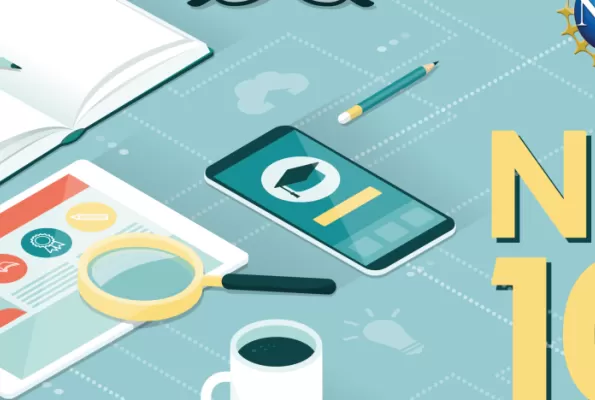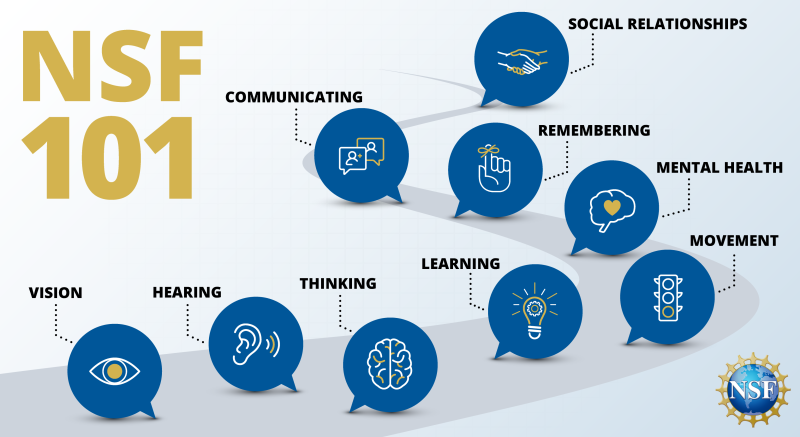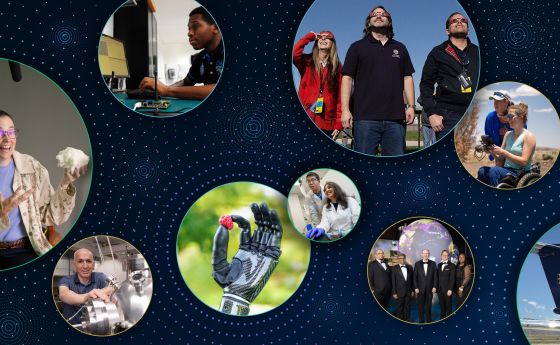
NSF 101: Agency accessibility resources
A diverse scientific workforce is essential to a highly successful research enterprise. Reducing the barriers for individuals with disabilities not only enriches the community, but is essential to moving scientific progress forward. The U.S. National Science Foundation addresses those barriers in many ways — from directly supporting individuals' access needs to supporting research that addresses fundamental challenges.
Grantees with current funding can reach out directly to their funding program officer about adding access needs into the original grant through a supplement. Applicants who are applying for a core funding proposal can reach out to a program officer to discuss their access needs and whether adding on additional support in their budgets is appropriate or if they would need to pursue other mechanisms. More specific opportunities for funding are discussed below.
Who needs access support?
The Centers for Disease Control and Prevention estimate that 1 in 4 adults lives with a disability, defined by the "Americans with Disabilities Act" as "a person who has a physical or mental impairment that substantially limits one or more major life activities, a person who has a history or record of such an impairment, or a person who is perceived by others as having such an impairment." Many disabilities may not be visible to observers or consistent with what is typically portrayed in media depictions, but all are covered by Sections 504 and 508 of "The Rehabilitation Act of 1973," the statute which protects people with disabilities in the federal sector. Section 508 ensures that everyone — especially employees and members of the public — has equal access to and use of electronic information technology, while Section 504 ensures equal access to government programs and services by requiring reasonable accommodations. Both sections apply to all NSF activities and facilities.
Access can be supported for, but not limited to, those who face limitations in:
What support can NSF provide?
There are several funding opportunities for researchers who have access needs and for those addressing accessibility and adaptive technology as a research topic. A list of current research opportunities can be found on NSF's Directorate for Education and Human Resources website. Each has a full list of contacts, program criterion, due dates and previously funded awards. Program officer contacts are also included, and more information on working with a program officer can be found in this Science Matters article.
All NSF locations (physical and virtual) are covered by Section 504 reasonable accommodations and Section 508 accessibility requirements. Anybody participating in programming, regardless of the length of time involved, can request reasonable accommodations. Each of these sections covers a slightly different set of resources, but if you are ever in doubt, you can email rarequest@nsf.gov with confidential questions.
So, what kind of accommodations might be provided? That answer varies based on what an individual might need. Some examples may include video remote American Sign Language interpreting, Communication Access Realtime Translation captioning service, speech-to-text software, direct flights for NSF official business travel, more space for mobility concerns, ergonomic seating and workstations, note-taking services, access to assistive technology and other support, but is not limited to any specific list.
What can everyone do to ensure accessibility for more people?
There are many things that everyone can do to make the world more accessible. A little extra time or effort may be required up front, but the impacts will be significant. Planning is essential to ease of access. If you are hosting a panel or conference, think through how people will access the meeting space — onsite or virtually — and plan for what to do if someone is unable to access the program to participate fully. If you have participants joining, invite them to request accommodations as early as possible — preferably 10 business days before the meeting date. This allows NSF's accessibility stakeholders sufficient time to coordinate and work with participants to arrange accommodations to ensure ease of access.
Meeting materials should also be made accessible as a default. Document creators should use the integrated accessibility checker available in Microsoft Office 365 or other tools used to author meeting materials to ensure that images include proper alternative text descriptions and sufficient color contrast and that proper document formatting/layout is used to ensure the information can be read by those who are color blind or have other vision impairments. For instance, individuals with visual impairments who use screen reader assistive technology to access documents should be able to easily navigate and move from one part of a document to another to hear descriptions of images and understand information communicated in text and table format as easily as others who do not use assistive technology. If you are unsure how to create accessible documents, contact the NSF Section 508 accessibility compliance officer to access resource information.
What other support mechanisms are out there?
NSF is not the only resource for increasing access. Many universities have their own on-campus digital accessibility liaisons or accessibility centers and funding opportunities, many of which are simply underutilized by researchers and students alike. Search online for your university's name and keywords "ADA/504," "Section 508," or "Accessibility" to find accessibility resources and staff who can help steer you in the right direction and provide local support services and resources.
If you do not know where to start or what to ask for, more general information can be found on the Job Accommodation Network and Section508.gov websites.






